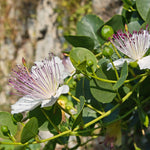Subscribe and save 10%!

Caper Bush (Capparis spinosa)
32 SEK
Unit price perExpected delivery date: 11 January to 18 January.
Applies to orders within Sweden. For other countries - see our delivery terms .
In stock - Ready to be shipped
Share
SEEDS (20pcs/bag)
Common name: Caper, Caper Bush, Flinders Rose
Scientific name: Capparis spinosa
Family: Capparaceae
Plant history & use:
The Caper Bush is a Mediterranean plant that have a long history of being cultivated for its edible unopened flower buds. After picking, they are put in salt to release bitter compounds and to bring out the sourness. This is the kind of capers we often see canned in stores. You can also let the flowers remain on the plant until they eventually turn into fruits, the fruits can then similarly be put into salt to be made ready for consumption.
Preserving capers is very easy. It can be broken down into 4 steps:
- Put the fresh flower buds/fruits in a bowl of salt
- Leave the buds/fruits in the bowl with salt for 3-7 days (or longer if desired).
- Drain the water that accumulates in the bowl and add some extra salt every day.
- When preservation is finished, rinse off the salt from the buds/fruits and soak them in water. Soaking time is up to your own taste, but recommended minimal time is 15 minutes. You can soak for several hours if desired. Grab a spoon and make a taste test every once in a while to find the flavor that suits you.
You can also pickle younger shoots and leaves from the Caper Bush. If you want to use slightly older leaves and shoots, a tip is to blanch them in boiling water for 2-3 minutes before pickling. Mix your caper shoots & leaves with salt and vinegar, leave in the fridge for about 1 month. Ready to eat.
Cultivation of capers has been traced back as far as 7,000 years ago in present-day Turkey, Jordan and Syria. There, it is believed to have been used for both culinary and medicinal applications. In medicinal use, all plant parts were used, most prominently as a digestive aid.
In tropical & sub-tropical food forests (agroforestry) it is effectively used in the lower layer as a ground cover plant.
Cultivation:
In its natural environment, capers often grow in high temperatures and soils with poor water and nutrient availability. A typical adaptation to a nutrient-poor environment is its very widespread root system, which makes it suitable as a soil binder in shorelines or eroding soils etc. In its natural environment, it is often growing on rocky cliffs and slopes. It grows on the walls of many ancient Mediterranean fortifications. The caper is an easily cultivated bush for home growers in the Mediterranean region (Spain, Italy, Greece, the coastal Balkan countries and south & west Turkey).
The Caper Bush develops an extensive root system, hence it grows best in deep, medium-textured, loamy soils.
In temperate climate, capers are best grown in pots in bright locations and overwintered frost-free. Capers are characterized by an initial upright growth to later grow long horizontal lateral shoots that spread along the ground - or hang down along the wall that the plant has mounted.
The bush is productive and in optimal conditions there can be good harvests of up to 3000 buds per bush and season. In temperate climate, you can't really expect the same results, but you can do your best to mimic the plant's natural environment by:
- put it in direct sunlight throughout the summer months,
- let it grow in well-drained Mediterranean soil
- let the soil dry out between waterings.
It's recommended to transplant your Caper Bush into a larger pot as the plant grows bigger.
As mentioned earlier, you harvest either the unopened flower buds or the fully formed fruits. If the flower bud is allowed to bloom, the bush produces sweetly scented, spectacular flowers. The Caper Bush can flower already in the first year sown from seed.
Caper buds are usually picked in the morning since that is when they're believed to have their highest aromatic value.
The Caper plant an be propagated via cuttings.
Sowing:
Caper seeds germinate irregularly. To create better germination conditions:
- Soak the seeds in lukewarm water for 1 day
- Place the seeds between two pieces of damp tissue paper/moist sand and leave in the fridge for 4-6 weeks
- Soak the seeds one final time in lukewarm water for 1 day
- Sow seeds 0.5 cm deep in sowing soil
The roots of the young caper plants are usually easily disturbed and are sensitive to damage when transplanting. A good solution can be to sow the seeds in degradable growing trays that you can seamlessly transplant into a larger pot without disturbing the roots.
Characteristics:
Lifespan: Perennial
Location: Sun
Height: 50 cm
Germination Time: 1-12 weeks
USDA Zone: 8-10
- Choosing a selection results in a full page refresh.
- Opens in a new window.














